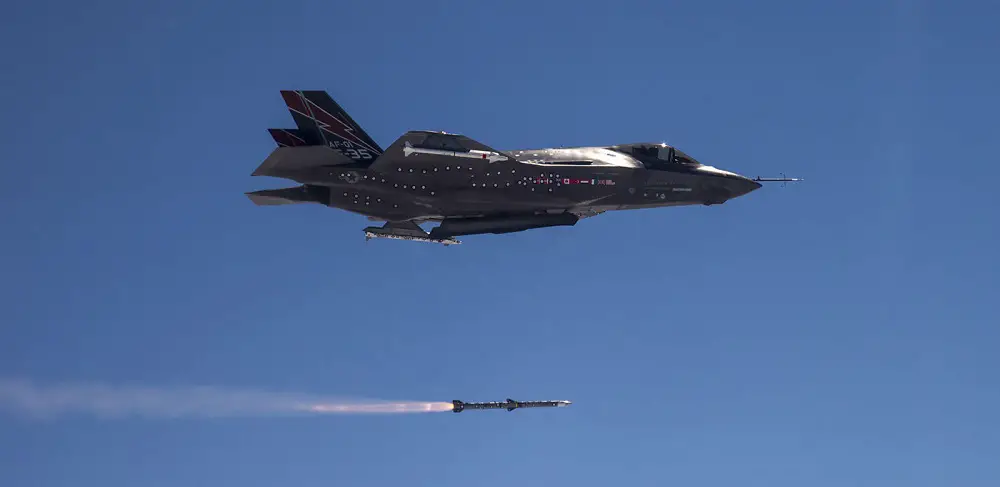The U.S. State Department has made a determination approving a possible Foreign Military Sale to the Government of Norway of AIM-120 C-8 or D Advanced Medium-Range Air-to-Air Missiles (AMRAAM) and related equipment for an estimated cost of $950 million. The Government of Norway has requested to buy up to two hundred five (205) AIM-120 D-series Advanced Medium-Range Air-to-Air Missiles (AMRAAMs); up to sixty (60) AIM-120 C-8 or D-series AMRAAMs; and four (4) AIM-120D AMRAAM Guidance Sections. Also included are AIM-120 Control Sections, Captive Air Training Missiles (CATMs), and missile containers. The proposed sale will improve Norway’s capability to meet current and future threats by providing advanced air-to-air capability for its F-35A fleet, enabling it to fulfill NATO missions and meet U.S. European Command’s goal of combined air operations interoperability and standardization between Norwegian and U.S. forces. The principal contractor will be Raytheon Missile Systems Company, Tucson, Arizona. There are no known offset agreements proposed in connection with this potential sale.
The AIM-120 Advanced Medium-Range Air-to-Air Missile, or AMRAAM, is an American beyond-visual-range air-to-air missile (BVRAAM) capable of all-weather day-and-night operations. It is 7 inches (18 cm) in diameter, and employs active transmit-receive radar guidance instead of semi-active receive-only radar guidance. It is a fire-and-forget weapon, unlike the previous generation Sparrow missiles which needed guidance from the firing aircraft. When an AMRAAM missile is launched, NATO pilots use the brevity code Fox Three. The AMRAAM is the world’s most popular beyond-visual-range missile; as of 2008 more than 14,000 had been produced for the United States Air Force, the United States Navy, and 33 international customers. The AMRAAM has been used in several engagements, achieving sixteen air-to-air kills in conflicts over Iraq, Bosnia, Kosovo, India, and Syria. The AIM-260 JATM, expected to reach operational capability in 2022, is expected to replace the 1991 AMRAAM.
AMRAAM uses two-stage guidance when fired at long range. The aircraft passes data to the missile just before launch, giving it information about the location of the target aircraft from the launch point and its direction and speed. The missile uses this information to fly on an interception course to the target using its built-in inertial navigation system (INS). This information is generally obtained using the launching aircraft’s radar, although it could come from an infrared search and track system, from a data link from another fighter aircraft, or from an AWACS aircraft. After launch, if the firing aircraft or surrogate continues to track the target, periodic updates—such as changes in the target’s direction and speed—are sent from the launch aircraft to the missile, allowing the missile to adjust its course, via actuation of the rear fins, so that it is able to close to a self-homing distance where it will be close enough to “catch” the target aircraft in the basket.
The AIM-120C deliveries began in 1996. The C-variant has been steadily upgraded since it was introduced. It was successfully tested in 2003 and is currently being produced for both domestic and foreign customers. It helped the U.S. Navy replace the F-14 Tomcats with F/A-18E/F Super Hornets – the loss of the F-14’s long-range AIM-54 Phoenix missiles (already retired) is offset with a longer-range AMRAAM-D. The lighter weight of the enhanced AMRAAM enables an F/A-18E/F pilot greater bring-back weight upon carrier landings. The AIM-120D is an upgraded version of the AMRAAM with improvements in almost all areas, including 50% greater range (than the AIM-120C-7) and better guidance over its entire flight envelope yielding an improved kill probability (Pk). Raytheon began testing the D model on August 5, 2008, the company reported that an AIM-120D launched from an F/A-18F Super Hornet passed within lethal distance of a QF-4 target drone at the White Sands Missile Range. The range of the AIM-120D is classified, but is thought to extend to about 100 miles (160 km).















